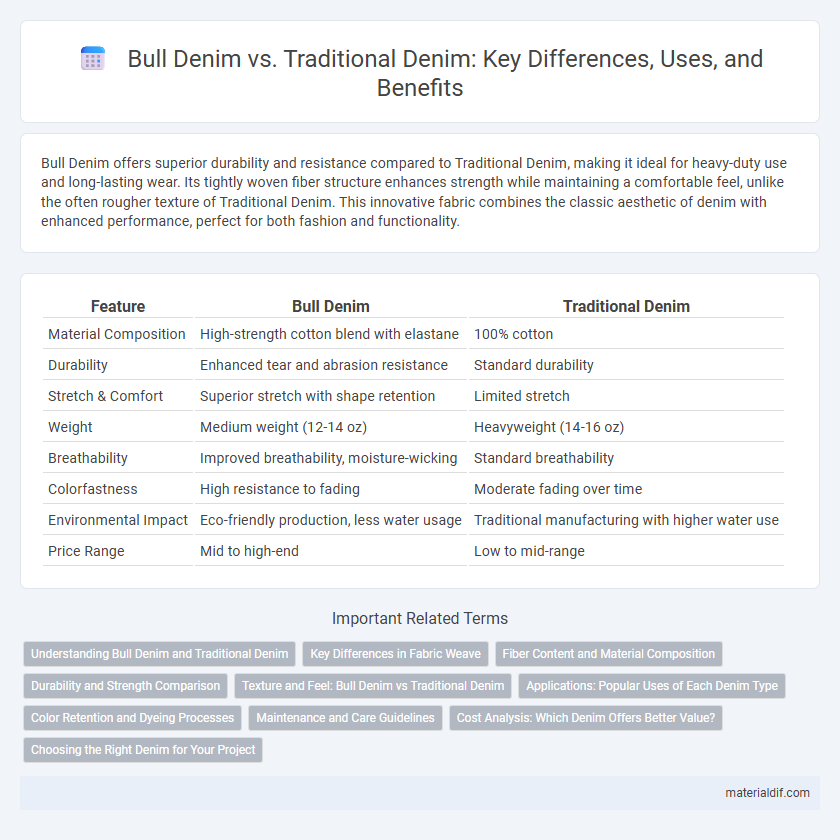Bull Denim offers superior durability and resistance compared to Traditional Denim, making it ideal for heavy-duty use and long-lasting wear. Its tightly woven fiber structure enhances strength while maintaining a comfortable feel, unlike the often rougher texture of Traditional Denim. This innovative fabric combines the classic aesthetic of denim with enhanced performance, perfect for both fashion and functionality.
Table of Comparison
| Feature | Bull Denim | Traditional Denim |
|---|---|---|
| Material Composition | High-strength cotton blend with elastane | 100% cotton |
| Durability | Enhanced tear and abrasion resistance | Standard durability |
| Stretch & Comfort | Superior stretch with shape retention | Limited stretch |
| Weight | Medium weight (12-14 oz) | Heavyweight (14-16 oz) |
| Breathability | Improved breathability, moisture-wicking | Standard breathability |
| Colorfastness | High resistance to fading | Moderate fading over time |
| Environmental Impact | Eco-friendly production, less water usage | Traditional manufacturing with higher water use |
| Price Range | Mid to high-end | Low to mid-range |
Understanding Bull Denim and Traditional Denim
Bull Denim is a heavyweight, durable fabric known for its rugged texture and enhanced resistance to wear, making it ideal for workwear and outdoor apparel. Traditional Denim typically features a medium-weight cotton twill weave, valued for its versatility, comfort, and classic look used in everyday clothing. Both types employ indigo or other dye techniques but differ significantly in weight, texture, and intended durability.
Key Differences in Fabric Weave
Bull denim features a tighter, diagonal twill weave compared to traditional denim's looser, more pronounced twill pattern, resulting in enhanced durability and a stiffer texture. The bull denim weave uses heavier yarns, providing greater resistance to abrasion and a distinct rigidity ideal for workwear. Traditional denim typically employs a softer, more flexible weave that breaks in over time, offering comfort and a classic faded aesthetic.
Fiber Content and Material Composition
Bull Denim features a high percentage of heavyweight cotton fibers combined with a small blend of synthetic elastane for enhanced stretch and durability, contrasting with traditional denim that primarily consists of 100% cotton fibers. The inclusion of elastane in Bull Denim improves flexibility and comfort while maintaining the rugged texture associated with classic denim. Traditional denim's pure cotton composition offers breathability and authenticity but lacks the added stretch and resilience found in Bull Denim's composite material.
Durability and Strength Comparison
Bull Denim outperforms traditional denim in durability due to its thicker yarns and tighter weave, resulting in enhanced resistance to wear and tear. The fabric's robust composition increases tensile strength, making Bull Denim ideal for heavy-duty applications and long-lasting garments. Traditional denim, while comfortable, generally lacks the reinforced fibers that provide Bull Denim with superior structural integrity.
Texture and Feel: Bull Denim vs Traditional Denim
Bull Denim features a coarser, more robust texture compared to traditional denim, providing enhanced durability and a rugged feel ideal for heavy-duty wear. Traditional denim offers a smoother, softer hand feel, making it more comfortable for everyday casual use. The distinct weave density in Bull Denim results in a stiffer fabric, while traditional denim's lighter weave allows for greater flexibility and breathability.
Applications: Popular Uses of Each Denim Type
Bull Denim is prized for its exceptional durability and heavyweight fabric, making it ideal for workwear, heavy-duty jackets, and rugged outdoor apparel that require enhanced abrasion resistance. Traditional Denim, with its lighter weight and flexibility, is widely used in everyday garments such as jeans, casual shirts, and fashion-forward apparel for comfort and style. Each type serves distinct markets based on performance needs, with Bull Denim dominating industrial and utility clothing and Traditional Denim preferred in casual and mainstream fashion applications.
Color Retention and Dyeing Processes
Bull Denim utilizes advanced synthetic indigo dyes and reactive dyeing techniques that enhance color retention significantly compared to traditional denim, which relies on natural indigo and conventional dye baths. The modern dyeing process in Bull Denim ensures deeper fiber penetration and reduced fading after multiple washes. Traditional denim often exhibits a worn look due to surface-level dyeing, whereas Bull Denim maintains vibrant, long-lasting hues thanks to proprietary dye fixation methods.
Maintenance and Care Guidelines
Bull Denim offers superior durability and requires less frequent washing compared to traditional denim, preserving its color and texture longer. Unlike traditional denim, which often demands cold water washing and air drying to prevent shrinkage and fading, Bull Denim can withstand higher temperatures and occasional machine drying without significant damage. Proper care for Bull Denim includes minimal washing, spot cleaning, and avoiding harsh detergents to maintain its robust fabric and unique finish.
Cost Analysis: Which Denim Offers Better Value?
Bull denim typically offers better value than traditional denim due to its enhanced durability and longer lifespan, reducing the need for frequent replacements. Although initial costs for bull denim may be higher, the investment is offset by savings on maintenance and fewer purchases over time. Traditional denim often requires more care and tends to wear out faster, increasing overall expenses despite the lower upfront price.
Choosing the Right Denim for Your Project
Bull Denim offers enhanced durability and a heavier weight compared to traditional denim, making it ideal for projects requiring long-lasting and robust fabric. Traditional denim provides greater softness and flexibility, suitable for garments needing comfort and breathability. Selecting the right denim depends on the specific requirements of your project, balancing strength and texture for optimal performance.
Bull Denim vs Traditional Denim Infographic

 materialdif.com
materialdif.com